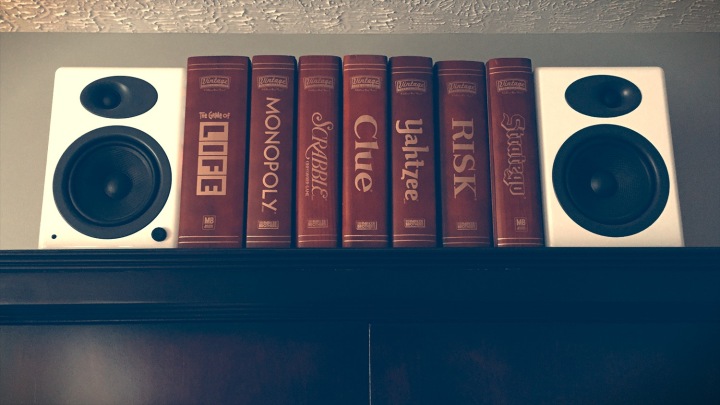Music to your ears.
Our family listens to music. Constantly.
I don’t know if it’s because of our industry (we work from home a lot), but we normally have one room in the house cranked up at least once a day. Daft Punk while I’m coding and spontaneous dance parties with the kids are just part of our daily routine. We even love listening to the evolution of music.
From the conversations I’ve had through this blog, I know many of you live the same way. With that in mind, part of our journey over the coming weeks will seek to shed some light on the most popular solutions out there in an effort to help us all navigate a very crowded marketplace.
Let’s kick that off today by discussing a few of the most popular speaker solutions that are common to home listening. First up, your computer.
Your Computer/Phone/Tablet’s Speakers
I realize that what you have with you is better than nothing at all, but what a crummy way to enjoy your favorite music. I spent most of my 20s thinking my laptop and $30 Dell speakers were awesome (CRANK UP THAT BASS!!!), and then I picked up a nice speaker system and never looked back. You don’t realize how much of the nuance is missing from your favorite album until you hear it on the right setup. The difference can be striking.
Pros: Cheap, convenient, and always around.
Cons: Sounds awful. Can’t wirelessly stream from your smart phone or other devices.
The Old-School Home Stereo System
It’s weird how something that was a staple of the previous generation is nearly impossible to find in the home of a millennial. I don’t know of a single friend I’ve visited that has an actual stereo setup these days (excluding a home theater system, of course).
Still, if you live in an apartment or house that only has one prominent living area, investing in an old school stereo system with an amp and high end speakers might be a great fit. It’s a setup that’s not usually engineered for the digital area of wireless streaming and subscription libraries, but all it would take is a few cables and additional components to bring you up to speed. Check out the latest hifi equipment at Graham Slee HiFi.
Pros: Fantastic sound (if you build the system right). Flexible for legacy music formats like vinyl. Street cred with your father.
Cons: Typically very expensive, even with modern components. Less accessible to modern music consumption. Normally limited to one room of the house.
Bluetooth Speakers
This is probably the first upgrade that many folks consider due to the huge number of products on the market and the versatility that a portable speaker can offer. The leading offerings from Jawbone, Beats, and Bose are attractive products with loud and especially pronounced bass response (making them very popular with teens).
While these can be fun on the go, Bluetooth’s limited bandwidth isn’t the best fit for clarity and acoustic precision; these speakers probably won’t provide the stereo separation and dynamic range you’re looking for in the long run.
Pros: Affordable, (normally) portable, easy to set up, and loud volume with a lot of bass.
Cons: Poor dynamic range and stereo separation. Can’t handle high quality audio.
AirPlay Speakers
This has been my go-to solution for the last few years. We’re an Apple house, owning several MacBooks, iPhones, iPads, and more. With AirPlay conveniently built in to every one of those products, it is unbelievably simple to choose a different audio output source and enjoy whatever content you want to listen to.
I invested in a pair of Audio Engine A5’s a few years ago and connected them to an Apple AirPort Express to make them AirPlay friendly. I have to tell you, these speakers sound incredible; they’re probably the best speakers I’ve ever heard. The A5’s make it seem as if all of my favorite bands have released remastered albums just for me, complete with new harmonies and added layers of sonic delight.
The issue is AirPlay itself. As much as I want to love it, it is completely unpredictable and drops audio with annoying frequency. It can also be temperamental, with several of my devices refusing to connect until I power cycle everything in the chain. I do seem to have less trouble with our Apple TV that we keep in our bedroom, and these issues could be related to network congestion. Whatever the case, these issues are an unfortunate flaw with what would probably be my preferred home audio setup.
Pros: Fantastic audio quality. Built-in support with every modern Apple device. Works with every audio source on your iDevice.
Cons: Apple only. Frequent audio drop outs and fickle behavior (at least in our house). Limited speaker options unless you pair your own with an Airport Express. Music can only be played on one AirPlay device at a time.
Sonos Wireless HiFi System
Last, but certainly not least, there’s Sonos. Sonos is the 800lb gorilla in wireless home audio, and for good reason; they’ve created a premium product with premium sound that extremely reliable. That’s why they’re able to charge a premium price.
Sonos offers a large family of WiFi speakers that are controlled exclusively through the Sonos App on your smartphone, tablet, or computer. Their app can integrate dozens of the most popular music services in addition to the libraries you may have stored on your devices or home network.
The magic comes in their proprietary wireless mesh network that provides legendary reliability alongside of some truly fantastic sound quality. In what is probably their most compelling feature, Sonos speakers can also be linked together to sync music across your whole home, or have different albums playing in different zones. In my mind, it’s one of the most compelling home audio setups on the market.
Pros: Fantastic audio quality. Music syncs across multiple speakers. Excellent reliability and stability.
Cons: Expensive to get started. Only controllable via the Sonos software.
Which Route Are We Going to Go?
As I mentioned earlier, we’re probably going to move away from our AirPlay setup unless we see a dramatic increase in reliability with the robust router I’m using at the new place. I’ve received a few demo units from the fine folks at Sonos, and am really impressed with what I’m seeing so far. Expect a full review on those soon.
How about you… What does your audio setup look like? Have an opinion on any of the options mentioned above? Let me hear it in the comments below!

















I have an old (i.e. late ’90s) Aiwa home stereo in my office. It used to have a 5-minidisc changer and 3-cd changer but those crapped out almost a decade ago. But the aux-in still works and dang if the speakers aren’t still the best I’ve ever owned. So that’s my main setup.
For the rest of upstairs I have a Griffin Evolve Wireless Sound System hooked up to an Airport Express. The sound is pretty good at reasonable volumes, even if they aren’t all that loud. I used to be able to bring them outside or place them wherever around my house during a party to spread the music around. They are wireless, dead simple and rock solid. But I’ve had them since ’07 or so and they no longer hold a charge well, meaning I can’t count on them to last a whole party long when off the base.
Downstairs I often stream music to the Apple TV, listening on our home theatre setup. That sounds pretty good, but not perfect.
I’m super interested in a sonos setup. I love Airplay, but I know what you mean about it being fickle. Can you play Spotify from your phone to Sonos with as little effort as I can currently stream to my Airport Express (when it decides to show up on my airplay list)? 🙂
Adam – Yep, Sonos integrates your Spotify account directly into their app, making it super simple to use. More on that in the review next week.
Eric,
missing a very important alternative solution for the home automation space. First you need a couple of really nice speakers.
I’m fortunate to live here in Adelaide (Australia) where we have a couple of great speaker manufacturers including VAF (http://www.vaf.com.au/) and KRIX (http://www.krix.com.au/). And laws of physics means that to get the lower frequencies, size does matter . Those little boxes you’re playing with struggle to move the volume of air required.
For well under $1000 you can buy an AV receiver which has an ethernet port (i.e. can play back from your DNLA server, a USB drive plugged into the back of the router, or Internet sources such as Spotify) – or indeed wireless direct (i.e. without a router) streaming from the smart phone or tablet direct to the receiver. Supports AirPlay too . My preference happens to be for Yamaha, but Denon and Sony do similar I believe.
Now I happen to be building my own house and have the opportunity to hardwire both the computer network, and all the speaker cables. A luxury some people don’t have. On the other hand , I’ve always regarded the description of “wireless” speakers (such as Sonos ) that require a power supply as an oxymoron and hence false advertising. So a comparison with a real amplifier and speakers is perfectly valid as a “home automation audio” review as long as you use a network connection and a smart phone or tablet for control.
So I’d be curious to see how you’d go if you sweet talked one of your local hi-fi shops into lending you say a Yamaha RX-V677 and a pair of good (say) Paradigm speakers (I know they are Canadian/Chinese, I just thought I’d see if I could start an argument about good American speakers). And use your smart phone (and the Yamaha app) as a controller to playback a 192k/24 bit FLAC music track from a USB 3 hard drive attached to the router.
[Add if you think that sounds great, rustle up some extra speakers. Good ones. And then go and find your favourite music or concert recorded on Blu-ray in 5.1 surround. (I have mine ripped as ISOs on the server AND the backup low-power PC) because I use a PC to playback, but transcoding or using another format will also work.]
Now that’s how to listen to music as part of a home automation system. I’d be curious to see how you think your Sonos system sound in comparison. And just as importantly how the ease of setup and use compares.
Cheers,
Allan H
The pattern will be available right after you complete your payment in PDF format. For a digital pattern you won’t pay any shipping.